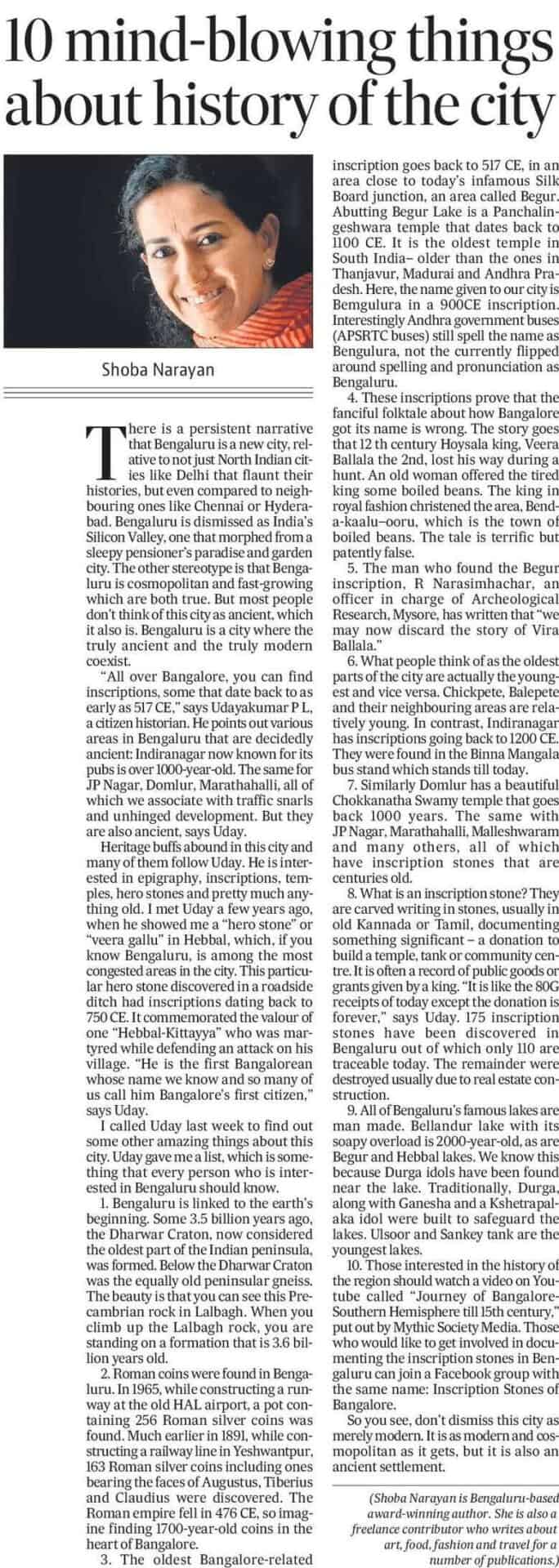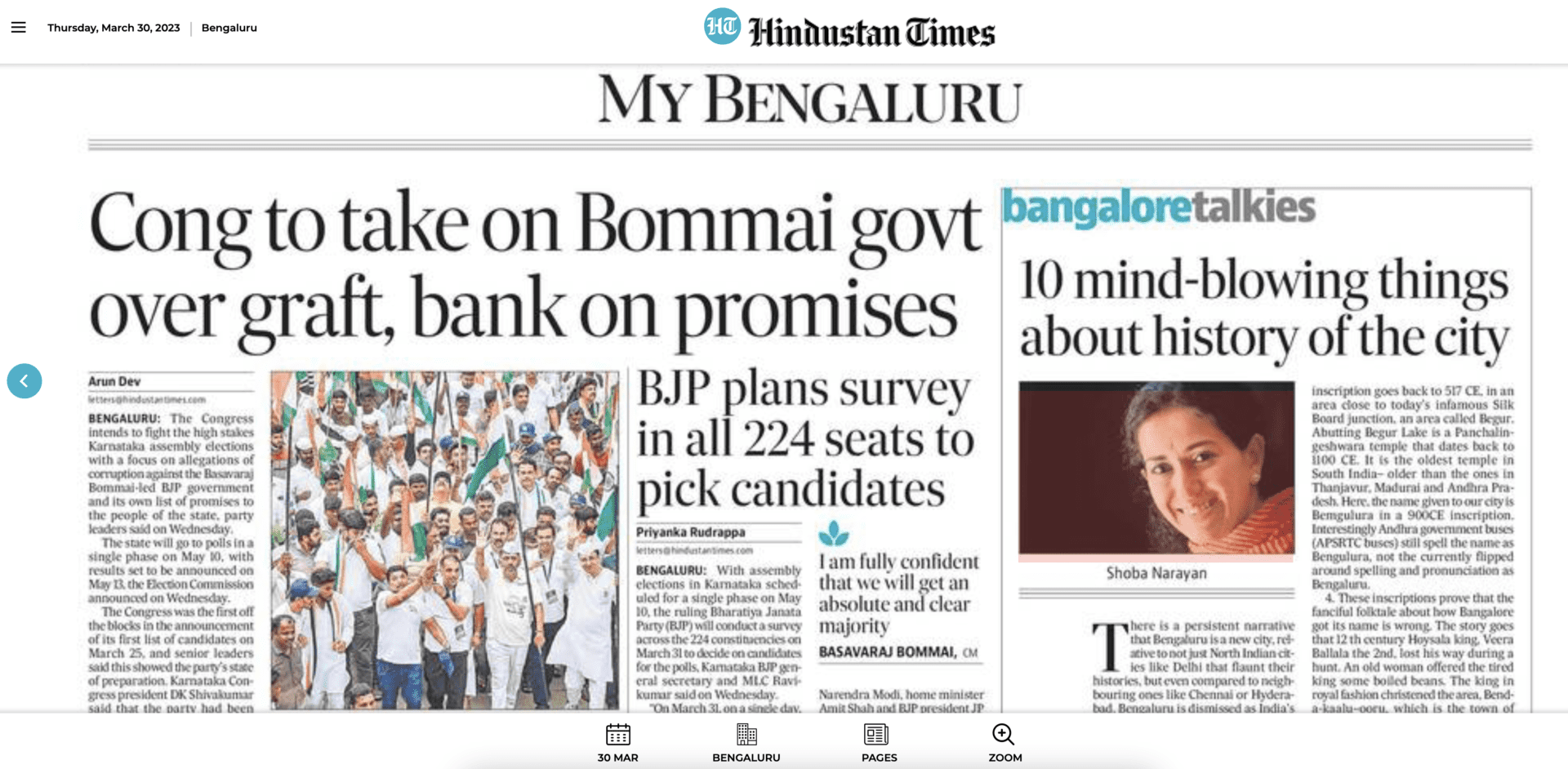There is a persistent narrative that Bangalore is a new city, relative to not just North Indian cities like Delhi that flaunt their histories, but even compared to neighbouring ones like Chennai or Hyderabad. Bangalore is dismissed as India’s Silicon Valley, one that morphed from a sleepy pensioner’s paradise and garden city. The other stereotype is that Bangalore is cosmopolitan and fast-growing which are both true. But most people don’t think of this city as ancient, which it also is. Bangalore is a city where the truly ancient and the truly modern coexist.
“All over Bangalore, you can find inscriptions, some that date back to as early as 517 CE,” says Udayakumar P.L, a citizen historian. He points out various areas in Bangalore that are decidedly ancient: Indiranagar now known for its pubs is over 1000 years old. The same for J.P. Nagar, Domlur, Marathahalli, all of which we associate with traffic snarls and unhinged development. But they are also ancient, says Uday.
Heritage buffs abound in this city and many of them follow Uday. He is interested in epigraphy, inscriptions, temples, hero stones and pretty much anything old. I met Uday a few years ago, when he showed me a “hero stone” or “veera gallu” in Hebbal, which, if you know Bangalore, is among the most congested areas in the city. This particular hero stone discovered in a roadside ditch had inscriptions dating back to 750 CE. It commemorated the valour of one “Hebbal-Kittayya” who was martyred while defending an attack on his village. “He is the first Bangalorean whose name we know and so many of us call him Bangalore’s first citizen,” says Uday.
I called Uday last week to find out some other amazing things about this city. Uday gave me a list, which is something that every person who is interested in Bangalore should know.

1. Bangalore is linked to the earth’s beginning. Some 3.5 billion years ago, the Dharwar Craton, now considered the oldest part of the Indian peninsula, was formed. Below the Dharwar Craton was the equally old Peninsular gneiss. The beauty is that you can see this Precambrian rock in Lalbagh. When you climb up the Lalbagh rock, you are standing on a formation that is 3.6 billion years old.
2. Roman coins were found in Bangalore. In 1965, while constructing a runway at the old HAL airport, a pot containing 256 Roman silver coins was found. Much earlier in 1891, while constructing a railway line in Yeshwantpur, 163 Roman silver coins including ones bearing the faces of Augustus, Tiberius and Claudius were discovered. The Roman empire fell in 476 CE, so imagine finding 1700 year old coins in the heart of Bangalore.
3. The oldest Bangalore-related inscription goes back to 517 CE, in an area close to today’s infamous Silk Board junction, an area called Begur. Abutting Begur Lake is a Panchalingeshwara temple that dates back to 1100 CE. It is the oldest temple in South India– older than the ones in Thanjavur, Madurai and Andhra Pradesh. Here, the name given to our city is BeMgUlurA in a 900CE inscription. Interestingly Andhra government buses (APSRTC buses) still spell the name as BengUlurA, not the currently flipped around spelling and pronunciation as BengAlurU.
4. These inscriptions prove that the fanciful folktale about how Bangalore got its name is wrong. The story goes that 12 th century Hoysala king, Veera Ballala the 2nd, lost his way during a hunt. An old woman offered the tired king some boiled beans. The king in royal fashion christened the area, Benda-kaalu–ooru, which is the town of boiled beans. The tale is terrific but patently false.
5. The man who found the Begur inscription, R.Narasimhachar, an officer in charge of Archeological Research, Mysore, has written that “we may now discard the story of Vira Ballala.”
6. What people think of as the oldest parts of the city are actually the youngest and vice versa. Chickpete, Balepete and their neighbouring areas are relatively young. In contrast, Indiranagar has inscriptions going back to 1200 CE. They were found in the Binna Mangala bus stand which stands till today.
7. Similarly Domlur has a beautiful Chokkanatha Swamy temple that goes back 1000 years. The same with J.P.Nagar, Marathahalli, Malleshwaram and many others, all of which have inscription stones that are centuries old.
8. What is an inscription stone? They are carved writing in stones, usually in old Kannada or Tamil, documenting something significant– a donation to build a temple, tank or community centre. It is often a record of public goods or grants given by a king. “It is like the 80G receipts of today except the donation is forever,” says Uday. 175 inscription stones have been discovered in Bangalore out of which only 110 are traceable today. The remainder were destroyed usually due to real estate construction.
9. All of Bangalore’s famous lakes are man made. Bellandur lake with its soapy overload is 2000 years old, as are Begur and Hebbal lakes. We know this because Durga idols have been found near the lake. Traditionally, Durga, along with Ganesha and a Kshetrapalaka idol were built to safeguard the lakes. Ulsoor and Sankey tank are the youngest lakes.
10. Those interested in the history of the region should watch a video on Youtube called “Journey of Bangalore- Southern Hemisphere till 15th century,” put out by Mythic Society Media. Those who would like to get involved in documenting the inscription stones in Bangalore can join a Facebook group with the same name: Inscription Stones of Bangalore.





This was a treat to read. Thank you so much.
Wonderful to hear about our Bemagurlu, very interesting. Although I am not based in Blore now, my heart and soul still yearns for Bangalore. The story of Veera Ballalu and the pot of beans has been around but I always took it as a figment of imagination. There were many interesting things about Bangalore. This place was part of the Bahamani Sultanates and passed on to the Adil Shahis. One of the oldest Darga is at Avenue Road. Interestingly Avenue Road was so named by the British because the entire road was covered by tree lined avenues right from the Fort to the Jamia Masjid. Alas, now nothing remains. The Summer palace was in the centre of a garden covered right around by the Fort and that is why we still have names like Kengeri Gate, Ulsoor Gate and Upparpet Gate. The lake where the bus stand exists was within the Fort surrounding the areas of Magadi road where the Gate now demolished was known as Magadi Gate. The Chickpet, Sultanpet, etc came only during the later stages. Even on Bellary road there was an old structure which existed I think before the Maharajas or Hyder and Tipu rule and beyond this was the village of Anruthhalli where the famous war Bullocks of Hyder and Tipu were bred. Incidentally, under Hyder and Tipu there was a ban on Cattle slaughter much before the political parties have made it an issue. There should be light shed on the towers of Kempegowda and why it is relevant to know the correct history of Namma Blore.